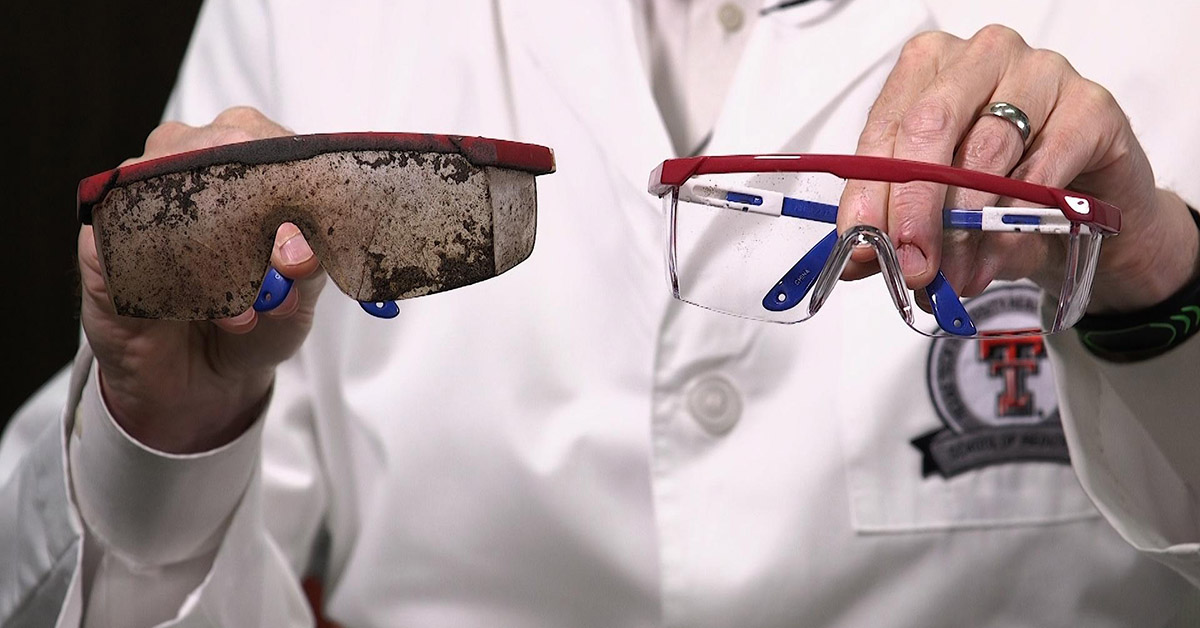The Eyes Have It
TTUHSC Expert Gives Advice on Eye Safety for Fourth of July Celebrations

As sunny days grow longer, West Texans grow excited for Independence Day and the staples of the season: swimsuits, barbeque and—of course—fireworks. Some enjoy lighting the fuses themselves while others prefer to view them with small groups of family and friends. Either way, there are precautionary steps that should be taken to protect one’s eyes and hands from the pyrotechnic hoopla.
According to the Consumer Product Safety Commission, 19 percent of the more than 9,000 fireworks-related injuries in 2018 were to the eyes. Kelly Mitchell, M.D., a professor in the TTUHSC Department of Ophthalmology and Visual Sciences, said approximately 30 percent of those eye injuries were to children, and that all of those affected, regardless of age can suffer a significant eye injury to one or both eyes, permanent decrease in visual acuity, complete vision loss or the loss of an eye.
To protect the eyes and promote overall safety during the use of fireworks, Dr. Mitchell recommends careful planning beforehand. The first sign of firework preparedness is obtaining the proper protective equipment.
“The data in our preventative medicine studies clearly show that goggles prevent the vast majority of eye injuries that occur across activities that we do for fun—sports, woodworking and fireworks celebrations,” said Mitchell, who believes all participants, even those watching, should use safety glasses for protection.
Mitchell pointed out that most local home improvement stores stock good quality glasses which can be purchased for as little as $10. Many online sources for safety glasses are also available, and provide appropriately-sized options for adults and children. Additionally, Mitchell said that anyone igniting fireworks should wear appropriate gloves to prevent injury and burns to the hands.
For those who would rather not pay for protective gear, Mitchell offers a reminder of the value of prevention.

“The only thing more expensive than being safe is being unsafe,” said Mitchell. “Emergency room visits, going to surgery and all the follow up care... versus a $10 pair of these goggles.”
Preparation also includes strict adult supervision. If adolescents are going to be allowed to light fireworks, Mitchell recommends limiting permission to those that are old enough to have a driver's license.
“There really isn't a safe firework that you can give a child,” said Mitchell, who advises that younger children only be allowed to watch fireworks. Although sparklers often are considered the safest fireworks for children, Mitchell said adults should carefully supervise their use and provide eye protection and gloves.
“Sparklers burn at about 2,000 degrees,” explained Mitchell. “About ten times the temperature of boiling water.”
Knowing where and when these colorful fuses will ignite is crucial. Mitchell suggested picking a safe place to light the fireworks that is a safe distance away from people (this will depend on the type of fireworks—the larger and more powerful types need a larger safe zone).
His other suggestions include having available water supply and avoiding lighting fireworks near woodpiles, flammable liquids, vehicles or piles of other fireworks. Afterwards, all unused fireworks should be either soaked in water and discarded or secured in a cool, dry location.
Even during well-planned celebrations, injuries can occur. If someone does suffer an injury to the eye, Mitchell advises resisting any temptation to try and remove material from the eyelid or the eye surface.
“I think the best thing to do,” said Mitchell, “is to calmly help that person get to an emergency room where they can be evaluated.”
For additional advice on ear safety, eye safety and protection from COVID-19 this Independence Day, review TTUHSC’s expert-recommended tip sheet.
Related Stories
Celebrating Veterans: TTUHSC’s General Martin Clay’s Legacy of Service and Leadership
From his initial enlistment in the Army National Guard 36 years ago to his leadership in military and civilian health care management roles, Major General Martin Clay’s career has been shaped by adaptability, mission focus and service to others.
Texas Tech University Health Sciences Center School of Nursing Named Best Accelerated Bachelor of Science in Nursing Program in Texas
The TTUHSC School of Nursing Accelerated Bachelor of Science in Nursing (BSN) program has been ranked the No. 1 accelerated nursing program in Texas by RegisteredNursing.org.
TTUHSC Names New Regional Dean for the School of Nursing
Louise Rice, DNP, RN, has been named regional dean of the TTUHSC School of Nursing on the Amarillo campus.
Recent Stories
TTUHSC Cancer Researcher Honored by National Academy of Inventors
C. Patrick Reynolds, M.D., Ph.D., director of the School of Medicine Pediatric Cancer Research Center at TTUHSC, has dedicated his life as a researcher to developing treatments for childhood cancers.
TTUHSC School of Nursing Celebrates 10 Years of the Veteran to BSN Program
The TTUHSC School of Nursing recognized the 10-year anniversary of the Veteran to Bachelor of Science in Nursing (VBSN) program during the fall 2025 commencement ceremonies held Dec. 13 in Lubbock, Texas.
TTUHSC Dean to be Inducted into the National Academies of Practice as Distinguished Fellow
Gerard E. Carrino, Ph.D., MPH, dean of the TTUHSC Julia Jones Matthews School of Population and Public Health, will be inducted into the National Academies of Practice (NAP) as a Distinguished Fellow of the Public Health Academy.
